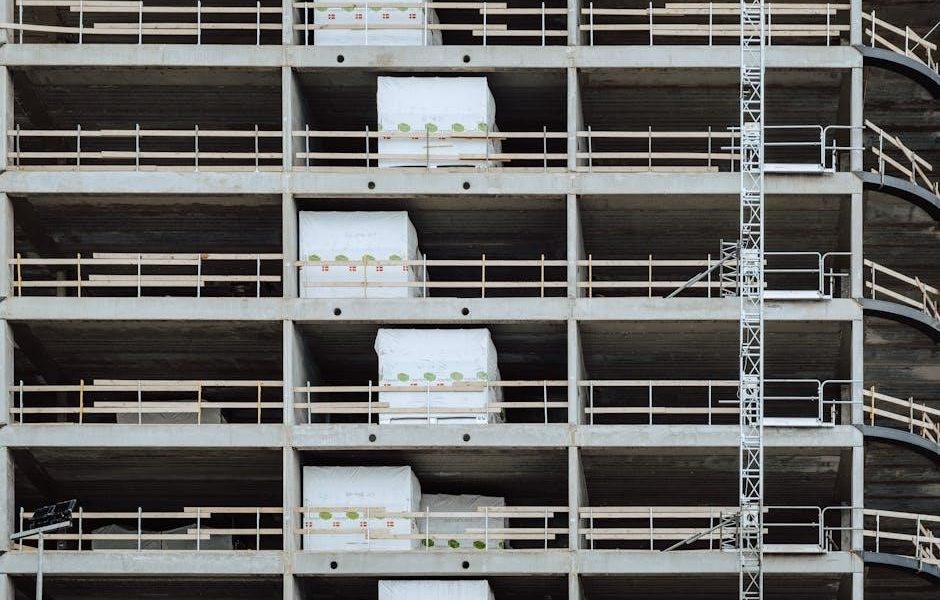
building construction materials list pdf
Building construction materials form the backbone of every project, ensuring strength and sustainability. From concrete and steel to wood and masonry, these elements are crucial for architectural durability and structural integrity.
Importance of Construction Materials in Building Projects
The selection of appropriate construction materials is crucial for ensuring the structural integrity, safety, and durability of buildings. Materials like concrete, steel, wood, and masonry provide the necessary strength and stability to withstand various environmental conditions. Their thermal performance and fire resistance are essential for occupant safety and energy efficiency. Additionally, the use of sustainable materials helps reduce the environmental impact of construction projects. By carefully choosing materials, builders can optimize cost, quality, and environmental performance, ensuring long-lasting and functional structures.
Classification of Building Materials
Building materials can be classified into natural and artificial categories. Natural materials include wood, stone, sand, and lime, which are readily available and often require minimal processing. Artificial materials, such as concrete, steel, glass, and polymers, are manufactured to meet specific performance requirements. Additionally, materials can be categorized by their function: structural materials like concrete and steel provide strength and stability, while finishing materials such as plastics and gypsum enhance aesthetics. Masonry materials, including bricks, blocks, and mortar, are specialized for wall construction. Proper classification ensures the right material is selected for its intended purpose, balancing durability, cost, and sustainability in building projects.

Common Building Construction Materials
Common building materials include concrete, steel, wood, masonry, bricks, blocks, and aggregates, each offering unique properties for structural integrity and durability in construction projects.
Concrete and Cement
Concrete and cement are fundamental materials in construction, offering exceptional strength and durability. Concrete, a composite material, consists of cement, water, aggregates (sand, gravel), and admixtures. It is widely used in foundations, walls, and slabs due to its high compressive strength and versatility. Cement, the primary binder, reacts with water to form a paste that hardens and binds aggregates together. Different types of cement, such as Portland cement, are tailored for specific applications. Concrete’s durability makes it ideal for structural components, while its moldability allows for diverse architectural designs. Proper mixing and curing are critical to achieve optimal performance. Cement production, while energy-intensive, continues to evolve with sustainable practices to reduce environmental impact.
Steel and Structural Steel (I-beams, H-beams)
Steel and structural steel are vital in modern construction, prized for their strength, durability, and versatility. Structural steel, including I-beams and H-beams, is widely used in framing buildings, bridges, and other large structures due to its high strength-to-weight ratio. These beams provide exceptional load-bearing capacity and are fabricated to precise dimensions for consistency. Steel’s ability to be shaped and welded makes it ideal for complex designs. Additionally, steel is recyclable, contributing to sustainable construction practices. Different grades of steel offer varying levels of tensile strength, ensuring suitability for diverse applications. From residential frames to high-rise skyscrapers, steel remains a cornerstone of structural integrity and architectural innovation, balancing performance and environmental considerations in building projects.
Wood and Timber (Softwood, Hardwood)
Wood and timber are timeless construction materials, offering sustainability and versatility. Softwood, derived from coniferous trees like pine, is lightweight and cost-effective, making it ideal for framing, insulation, and interior finishes. Hardwood, from deciduous trees such as oak, is denser and more durable, often used for flooring, furniture, and structural elements requiring high strength. Both types are renewable and eco-friendly, with proper forestry practices ensuring their availability. Wood’s natural aesthetic appeal and ease of manipulation make it a preferred choice for architectural designs. Additionally, wood has good thermal insulation properties and can be treated to resist pests and decay, enhancing its longevity in construction projects. Its adaptability and environmental benefits make wood a cornerstone of sustainable building practices.

Masonry and Aggregate Materials
Masonry and aggregate materials are fundamental in construction, providing structural integrity and durability. They include bricks, blocks, stones, sand, gravel, and quarry stone, essential for building sturdy foundations and walls.
Bricks, Blocks, and Stones
Bricks, blocks, and stones are essential masonry materials, offering durability and structural strength. Bricks are versatile, used in walls and facades, while blocks are larger and ideal for load-bearing applications. Stones, such as quarry stone, add aesthetic and structural value, often used in foundations and decorative features. These materials are prized for their strength, fire resistance, and ability to withstand environmental conditions. Natural stones like granite and sandstone are sustainable options, while bricks and blocks provide consistency and ease of construction. Together, they form the backbone of durable and long-lasting buildings, ensuring quality and endurance in various architectural projects.
Aggregates (Sand, Gravel, Quarry Stone)
Aggregates, including sand, gravel, and quarry stone, are fundamental components in construction, providing strength and stability to structures. Sand, a fine aggregate, is essential for mortar and concrete mixes, ensuring smooth finishes. Gravel, a medium to coarse aggregate, enhances drainage and is often used in foundations and road construction. Quarry stone, the coarsest aggregate, adds structural integrity to large-scale projects. These materials are versatile, cost-effective, and widely available, making them indispensable in building projects; Their proper selection and mixing are critical for achieving optimal durability and performance in concrete and masonry applications. Aggregates are also key in landscaping and drainage systems, ensuring long-lasting and reliable construction outcomes.
Mortar and Binding Wires

Mortar is a vital binding agent in masonry construction, composed of cement, sand, and water. It fills gaps between bricks, blocks, and stones, ensuring structural integrity and durability. Binding wires, such as steel reinforcement, are used to strengthen masonry by providing tensile strength and resisting cracking. These wires are often embedded within mortar joints or used in reinforced masonry structures. Together, mortar and binding wires enhance the overall stability and load-bearing capacity of walls and structures. Proper application of mortar ensures a strong bond, while binding wires add resilience against stresses like earthquakes or heavy loads. Both materials are essential for modern masonry, combining flexibility and strength to create durable and long-lasting buildings. Their integration is crucial for achieving safe and reliable construction outcomes.
Specialized Construction Materials
Glass, plastics, and polymers add versatility, while gypsum and lime enhance durability. Bitumen and adhesives provide sealing and bonding solutions, advancing modern construction techniques and sustainability.
Glass and Plastics
Glass and plastics are versatile materials used in construction for their unique properties. Glass offers transparency, durability, and energy efficiency, making it ideal for windows, facades, and decorative elements. Plastics, including polymers, provide flexibility, lightweight solutions, and resistance to corrosion, often used in insulation, pipes, and composite materials. Types of glass include soda-lime, borosilicate, and tempered glass, each suited for specific applications. Plastics like PVC, polyethylene, and fiberglass are widely applied in construction due to their adaptability. Both materials enhance modern design, improve thermal performance, and contribute to sustainable building practices by reducing weight and increasing energy efficiency. Their versatility makes them essential in contemporary architecture and infrastructure development.
Gypsum, Lime, and Bitumen
Gypsum, lime, and bitumen are essential construction materials with unique applications. Gypsum is widely used in plaster, drywall, and ceilings due to its fire-resistant and insulating properties. Lime, often combined with water and sand, is a key component in mortar, plaster, and cement, providing durability and flexibility. Bitumen, a viscous petroleum derivative, is primarily used for waterproofing, road surfacing, and roofing. Together, these materials enhance structural integrity and provide specialized functions like thermal insulation, water resistance, and adhesive properties. Their versatility makes them indispensable in both traditional and modern construction projects, ensuring long-lasting and high-performance buildings.
Polymers and Adhesives
Polymers and adhesives play a critical role in modern construction, offering versatility and strength. Polymers like epoxy resin, polyurethane, and vinyl are used for coatings, sealants, and structural components, providing durability and resistance to environmental factors. Adhesives, such as acrylic and silicone-based products, ensure strong bonds between materials like wood, metal, and glass. These materials enhance structural integrity, reduce weight, and improve thermal performance. Their ability to withstand stress and environmental degradation makes them essential for bonding and sealing applications. Polymers and adhesives are integral to innovative building solutions, enabling the creation of lightweight yet robust structures. Their use contributes significantly to the efficiency and sustainability of construction projects.
Properties and Testing of Construction Materials
Construction materials are tested for strength, durability, and thermal performance to ensure structural integrity and environmental adaptability. Evaluating these properties is crucial for safe and sustainable building practices.

Strength and Durability
The strength and durability of construction materials are critical for ensuring structural integrity and longevity. Concrete, for instance, is tested for compressive strength, while steel is evaluated for tensile strength. Wood and masonry materials are assessed for their resistance to decay and load-bearing capacity. Durability also involves how well materials withstand environmental factors like moisture, temperature fluctuations, and chemical exposure. Testing methods, such as compression tests and flexural strength analyses, are employed to determine these properties. High-performance materials like reinforced concrete and treated timber are chosen for their ability to endure harsh conditions. Ensuring these qualities is essential for building safe, sustainable, and long-lasting structures that meet design specifications and environmental demands. Regular testing and certification of materials are vital to maintain reliability and safety in construction projects.
Thermal and Acoustic Performance

Thermal performance refers to how materials regulate heat transfer, ensuring energy efficiency and comfort. Materials like insulation, glass, and concrete are assessed for their ability to retain or reflect heat. Acoustic performance measures sound absorption and transmission, crucial for noise reduction. Wood, gypsum, and specialized plastics are often evaluated for their sound-dampening properties. Testing standards, such as thermal conductivity (U-value) and sound transmission class (STC), help determine these properties. Proper material selection enhances energy efficiency, reduces noise pollution, and improves occupant comfort. These factors are critical in modern construction, where energy savings and acoustic comfort are key priorities. Advanced materials and designs now offer superior thermal and acoustic solutions, meeting stringent building codes and environmental standards.
Fire Resistance and Sustainability

Fire resistance in construction materials is critical for safety, as it determines how well a material withstands flames and heat. Materials like concrete, steel, and gypsum are known for their high fire-resistant properties, while others, such as wood, may require treatments to enhance this trait. Sustainability focuses on the environmental impact of materials, including their production, use, and disposal. Recycled steel, sustainable wood (FSC-certified), and low-carbon concrete are examples of eco-friendly options. Modern construction emphasizes materials with high fire resistance and low environmental footprints, aligning with global efforts to reduce emissions and promote green building practices. These factors are essential for creating safer, more environmentally responsible structures.
Related posts:
Archives
- November 2025
- October 2025
- September 2025
- August 2025
- July 2025
- June 2025
- May 2025
- April 2025
- March 2025
- February 2025
- January 2025
- December 2024
- November 2024
- October 2024
- September 2024
- August 2024
- July 2024
- June 2024
- May 2024
- April 2024
- March 2024
- February 2024
- January 2024
- December 2023
- November 2023
- October 2023
- September 2023
- August 2023
- July 2023
- June 2023
- May 2023
Leave a Reply
You must be logged in to post a comment.